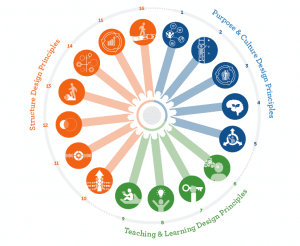16 Quality Principles to Guide Implementation of Competency-Based Education
CompetencyWorks Blog
 If you are just starting out or are midway in your process of making the transition to personalized, competency-based education, please take the time to read Quality Principles for Competency-Based Education. If you are in planning stages, be sure to read the first section, which is a primer on competency-based education including the flaws in the traditional system. It’s important to understand the problems with the traditional system so you can think about what you need to stop doing as well as what you want to put into place.
If you are just starting out or are midway in your process of making the transition to personalized, competency-based education, please take the time to read Quality Principles for Competency-Based Education. If you are in planning stages, be sure to read the first section, which is a primer on competency-based education including the flaws in the traditional system. It’s important to understand the problems with the traditional system so you can think about what you need to stop doing as well as what you want to put into place.
The best way to read Quality Principles for Competency-Based Education is either by purchasing the book or printing out the quality principles one at a time. Take the time to write down your questions, engage your peers in conversation about whether you think the quality principle makes sense in terms of helping students to learn, and what you have in place that you can build upon. This isn’t an implementation guidebook, as schools chose different entry points and roll-out strategies. Instead, it’s designed to help you make the shift in thinking from the top-down, time-based traditional system to the empowered, flexible system that is designed to make sure that every student is able to succeed and make progress toward college- and career-ready knowledge and skills.
The following are the list of blogs written about the quality principles. They are shorter introductions to each of the principles if you want to take a look to decide which one you want to pick to get started. My recommendation: Always start with Principle #6 Base School Design & Pedagogy on the Learning Sciences.
I’ll be continuing my efforts to make sense of how we can more easily modernize our schools at LearningEdge. I’d love to hear your reaction to Quality Principles for Competency-Based Education, especially if you have a misstep along the way. The more we can collect missteps, why they happened, and how to quickly correct them, the sooner we can create an implementation guidebook. In the meantime, a shared purpose, a trusting and inclusive culture, thinking hard about designing about what is best for kids to learn and develop, and a bit of courage will get you where you need to go. Oh and remember to celebrate lessons learned from mistakes and achievements, big and small, along the way!
16 Quality Principles
- Purpose-Driven
- Commit to Equity
- Nurture a Culture of Learning and Inclusivity
- Foster the Development of a Growth Mindset
- Cultivate Empowering and Distributed Leadership
- Base School Design and Pedagogy on Learning Sciences
- Activate Student Agency and Ownership
- Design for the Development of Rigorous Higher-Level Skills
- Ensure Responsiveness
- Seek Intentionality and Alignment
- Establish Mechanisms to Ensure Consistency and Reliability
- Maximize Transparency
- Invest in Educators as Learners
- Increase Organizational Flexibility
- Develop Processes for Ongoing Continuous Improvement and Organizational Learning
- Advance Upon Demonstrated Mastery